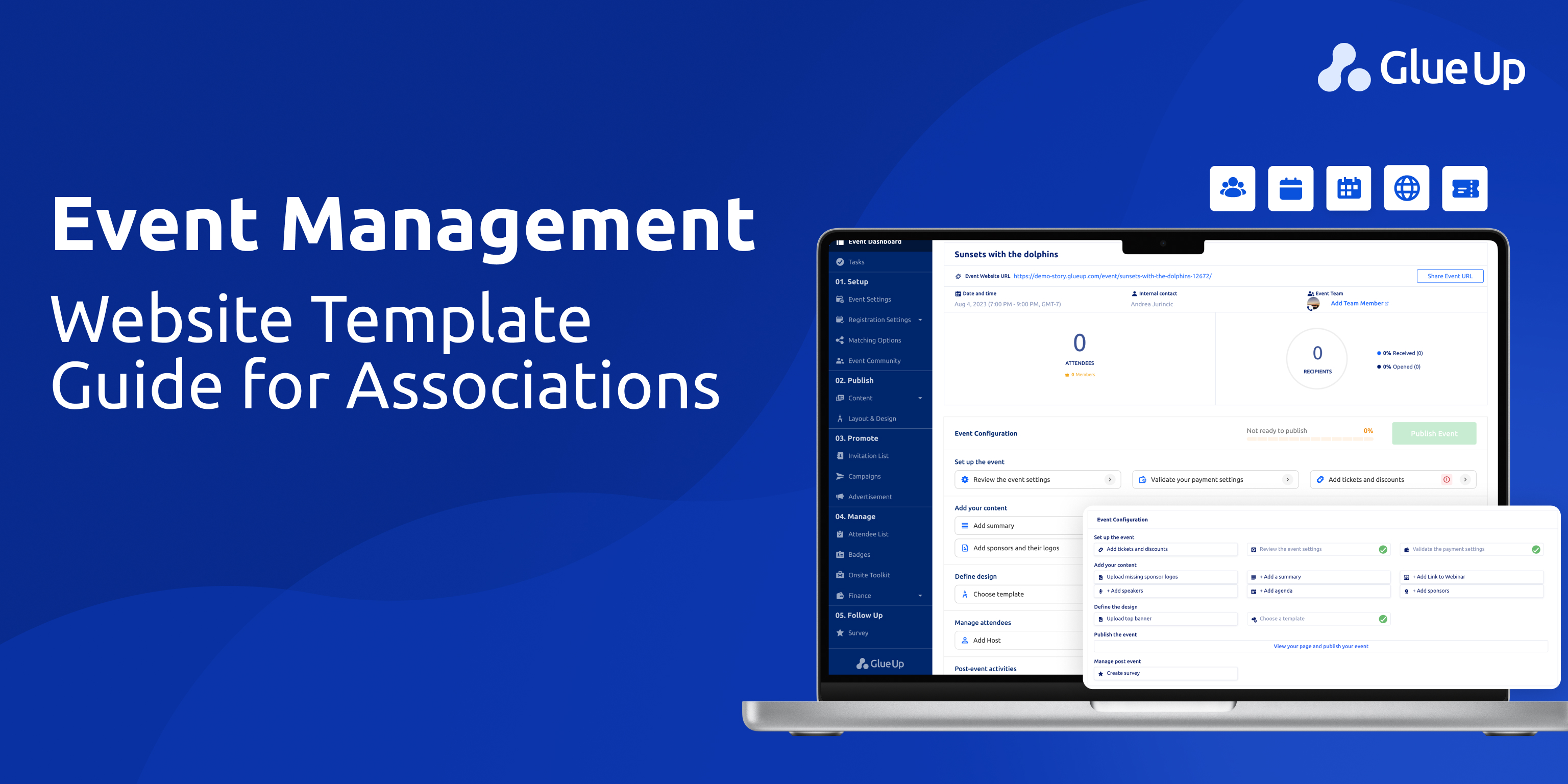
Event management website templates have become the new front door to association events. It wasn’t long ago that a polished invitation letter was enough to spark interest. Leaders carefully crafted each line, blending formality with persuasion to encourage RSVPs.
Over time, those letters shifted into inboxes as digital invitations with subject lines like “Don’t Miss Our Annual Conference” or “Reserve Your Spot Today.” But even the most compelling invitation only gets members to click, what happens after that is what truly determines whether they register.
That click leads to an event landing page, and the quality of the template behind it makes all the difference. Modern event management website templates are more than placeholders; they’re purpose-built environments that guide decisions, minimize friction, and turn curiosity into confirmed registrations.
For associations, events are revenue lifelines, member experiences, and reputation builders. The design of an event website, then, is not cosmetic polish but essential infrastructure. With rising expectations for hybrid formats, mobile-first design, and accessibility compliance, the importance of professional event management website templates is only increasing.
This is the roadmap: how associations can evolve from simple invitations to websites that consistently drive engagement, RSVPs, and lasting member loyalty.
Key Takeaways
- Invitations may get the click, but the website experience decides if people actually register. Speed, clarity, and accessibility are critical for keeping visitors engaged and converting them into attendees.
- High-performing templates include clear CTAs, agenda and speaker modules, tiered pricing logic, mobile-first layouts, add-to-calendar options, and built-in accessibility compliance to reduce friction and improve attendance.
- From AMS systems like WildApricot or GrowthZone to enterprise platforms like Cvent and Bizzabo, or DIY builders like WordPress; platform choice should match event scale and membership needs. Glue Up offers the best of both worlds with integrated membership and event tools.
- Small improvements, like simplifying forms, aligning messaging with invitations, and tracking GA4 key events; can dramatically boost registrations. Integrations with payments, CRMs, and virtual platforms turn event websites into data-rich, operational assets.
- For associations, events drive revenue, reputation, and member loyalty. Investing in professional event management website templates is no longer cosmetic, it’s foundational to long-term growth and stronger member connections.
Quick Reads
- How Event Management Tools Are Setting Standards • Glue Up
- Corporate Meetings and Events for Associations • Glue Up
- Essential Features to Look for in Event Management Software •
- 10 Super-Simple Event Website Templates that Wow Attendees •
- Event Planning Checklist: Associations & Chambers • Glue Up
- Event Management Platform for Modern Organizations • Glue Up
- Best Event Management Solutions for Associations • Glue Up
Why Event Management Website Templates Decide Your Registration Rate
Associations often overestimate the power of their invitation and underestimate the influence of the destination. A crisp subject line and a persuasive email will get someone to click “Register Now,” but if the website they land on loads slowly, asks for too much information, or buries the RSVP button below a wall of text, most people will leave.
Research shows that even a one-second delay in load time can reduce conversions by up to 20 percent on mobile. And considering that the majority of members and attendees now interact with organizations through smartphones first, responsiveness is the baseline feature.
Professional event management website templates solve this by focusing on speed, clarity, and accessibility. They remove unnecessary weight, prioritize clean form design, and follow WCAG accessibility standards that ensure everyone; including people using screen readers or keyboard navigation, can register without barriers.
For associations, this means the registration page is a digital handshake. It communicates competence, respect, and trustworthiness. Every misaligned button or broken mobile view whisper something else: that the organization is behind the times. And members have options, that impression can cost more than one missed RSVP.

Features That Matter in Event Management Website Templates
If you’ve ever walked into a conference center and instantly felt oriented, clear signage, logical flow, welcoming staff, you know the comfort of good design. An event website works the same way. The best event management website templates come packed with features that reduce friction and encourage completion.
Conversion-first hero sections: Right at the top, there should be one message, one clear CTA, and one reason to act. The cognitive load of making choices is the enemy of registrations.
Agenda and speaker modules: Attendees want to know what they’ll get. Responsive event templates display schedules with time-zone support, filters, and rich bios for speakers.
Pricing and ticketing logic: Associations need tiered pricing; member vs. non-member rates, early-bird discounts, group bundles. Templates should allow for complex logic without forcing custom development.
Accessibility baked in: Compliance with WCAG 2.2 AA means larger touch targets, visible focus states, and error help text for forms.
Add-to-calendar options: A small detail, but one that reduces no-shows dramatically. A “Save to Google/Outlook/Apple Calendar” button locks the commitment in.
Mobile-first layouts: With hybrid and virtual events, participants are just as likely to check details on a phone in an airport lounge as on a desktop in an office. Templates must adapt.
A conference website design should do more than inform, it should convert. When done well, it feels like a personalized concierge, anticipating what people need and giving it to them before they ask.
Best Platforms for Event Management Website Templates
Not all associations need the same toolkit, which is why the question of platform matters.
Association-focused AMS platforms: Solutions like WildApricot, Neon One, GrowthZone, or Novi AMS integrate membership data with events. These are ideal when you need event registration tied directly to member profiles, dues, and renewals.
Enterprise event platforms: Cvent, Bizzabo, Whova, and Hopin excel in conference-level sophistication; multi-day agendas, exhibitor portals, and hybrid networking tools. They’re built for complexity but come with higher costs.
DIY website builders: WordPress with plugins like Event Espresso, or Squarespace and Wix with event templates, are budget-friendly and quick to launch. They require more effort in integration but provide design control.
Glue Up sits in a hybrid position: an event website builder purpose-built for associations. It offers what AMS stacks provide (tiered member pricing, CRM integration, community tie-ins) while also delivering responsive, white-label corporate event website templates that match professional standards. That means associations can send the digital invitation, drive the click, and manage the full registration workflow without leaving the ecosystem.
Event Management Website Examples That Get It Right
Look at how major associations design their sites, and you’ll see patterns worth replicating.
ASAE Annual Meeting: Clear navigation for attendees, exhibitors, and speakers. Comprehensive but not overwhelming. The site serves as both a promotion tool and an operational guide.
APA Convention: Their event registration website excels at clarity, with timelines, FAQs, and registration steps presented in plain, accessible language.
AGU Meetings: These hybrid events use templates that tie directly into accounts, meaning attendees see pricing, sessions, and options tailored to them.
These examples are pretty and functional. Each one reduces friction at critical decision points, which is exactly what associations should emulate.
Customization That Actually Moves Numbers
Customization is where many associations stumble. They either overspend on developers or under-invest in templates, leaving themselves with clunky forms or inflexible designs.
The truth: customization doesn’t need to mean coding.
WordPress child themes let you adapt styles without breaking updates.
Responsive event templates allow brand alignment with logos, colors, and fonts while still keeping the skeleton optimized for performance.
Form design is a game-changer: eliminate optional fields, mark required fields clearly, and keep everything short. Studies show that fewer visible fields dramatically increase completion rates.
Message matching matters: if your email says “Reserve Your Seat in 2 Minutes,” your landing page should show a form that actually takes two minutes.
Analytics integration ensures you know where people drop off. Google Analytics 4 automatically tracks form starts and completions; promoting these to “key events” gives associations a clear conversion funnel.
In practice, that means less guesswork, more evidence. Customization should make the member’s path smoother, not heavier.
Integrations That Enhance Event Management
A template is only as strong as the ecosystem it connects to. For associations, that means integrating beyond the landing page.
Payments: Online event ticketing templates should link directly to invoicing systems, allowing credit card, ACH, or multi-currency support.
Virtual platforms: Zoom, Teams, or embedded streaming should connect seamlessly, avoiding the dreaded “register twice” problem.
Member systems: Registration data should flow back into the CRM, so renewal campaigns, engagement scores, and attendance histories update automatically.
Analytics: GA4 or similar should measure intent signals—form starts, pricing page views, and drop-off points.
Glue Up’s event websites are built with these integrations in mind. That means associations are creating a living data source that ties back to membership and engagement strategy.
Practical Questions Every Association Asks
Which platform is best for an event website?
It depends on scale. For member-centric needs, AMS platforms win. For massive conferences, enterprise systems shine. For tight budgets, WordPress or Wix are enough. For a balance of membership and event sophistication, Glue Up is built to serve associations directly.
Do I need a developer to customize templates?
Not usually. Most modern builders are drag-and-drop. If you want heavy customization or API work, a developer helps. But most associations can customize within the template framework without coding.
How much do event website templates cost?
WordPress conference templates run around $60–$80 one-time. Squarespace or Wix plans start in the $20–$40/month range. Enterprise systems are quote-based and can run into thousands per year. Glue Up’s pricing is customized, but it replaces multiple tools with one system.
What features are essential for hybrid event websites?
Time-zone aware agendas, embedded video, chat/Q&A, breakout sessions, and on-demand replay access. All wrapped inside a mobile-friendly, accessible hybrid event website design.
Why Glue Up Makes Event Management Website Templates Simple for Associations
Associations don’t need more tools. They need fewer, smarter tools that work together. Glue Up’s event management website templates are built inside the same platform that runs membership, finance, and community engagement.
That means:
Digital invitations feed directly into custom event landing pages.
RSVPs connect to a member’s profile, not a spreadsheet.
Online event ticketing templates sync with payment processing and finance reporting.
Engagement signals (RSVP, attendance, no-shows) update automatically, making retention campaigns smarter.
For members, it feels frictionless. For staff, it means one ecosystem instead of five disconnected ones.
See how Glue Up turns clicks into completed registrations, and events into stronger member connections.
Closing Reflection
Invitation letters started the journey. Digital invitations took it further. But today, the destination, the website is where decisions happen. Associations that treat their event websites as strategic assets will outpace those that still treat them as afterthoughts.
The shift from invitation letters to event management website templates is more than a change in format. It’s a signal of maturity. And for associations navigating retention pressures, hybrid demands, and member expectations, it might be the most important signal of all.



